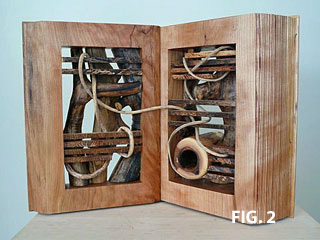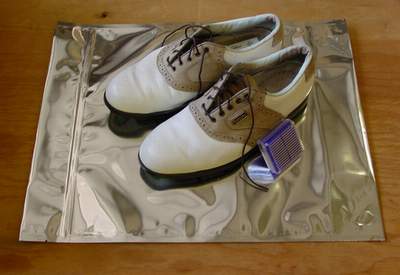
Preservation Technologies
Preservation Vs Time and Environment
The Power of Oxygen

What now sounds like common sense was not always the case for our understanding of preservation. One key study to prove the effectiveness of an oxygen free environment on keeping biological growth to a minimum was a collaboration between the Getty and various museums over the course of years. Starting in the 80s with a series of collaborative experiments centered around Egyptian Sarcophagi and other relics. Collected as part of a series of studies called Oxygen Free Museum Cases edited by Shin Maekawa, the overall goal of the study was to find effective and cost efficient means of preserving relics for both long term storage, and from the environmental factors introduced as some pieces traveled around the globe.
Having historical pieces go on "tour" in different countries has been a key part in cultural and historical exchanges. However, aside from just the physical stress shipping can bring, differing quality standards and environmental conditions in each country can reveal unknown issues with these treasures. In the case of Mr. Maekawa and the Egyptian Sarcophagus collection, changes to the relative humidity of the museum would cause drying and damage to some of the preserved bodies. On the other side of the spectrum, having too high a temperature and/or relative humidity would encourage bacterial growth, or even restart some insect life cycles that had been dormant in the relics. So the solution had to be both all encompassing to ensure the same level of preservation protection no matter the environment it was brought to, but also maintain an effective hold on any new deterioration possible.
When the study began in 1985, one of the more prolific forms of preservation was using a pressurized case filled with Nitrous gas to replace any stagnant air. While effective for long term exhibitions, this technique would often come with high maintenance costs, and require the handling of high pressure gas canisters. Similar styles using other chemical agents like Argon were also in use, but could leave residue or cause other unforeseen damage. For pieces as old and fragile as the Egyptian mummies, they could not take a chance. Even the standard case at that time was difficult to source parts and manufacture for museums like those in Cairo. So the team at the Getty went about redesigning the case to be reliable, but easy to assemble and manufacture for galleries around the world to model off of. After running some tests with the new design, they found one of the largest contributing factors to deterioration and/or biological growth was oxygen. As seen in the table above, to ensure bacterial growth is kept to a minimum, the ideal conditions require a Relative Humidity level of around 35% and an oxygen level below 0.1% within the case. Keeping the artifacts in an anaerobic environment was key in maintaining a stable and long lasting preservation environment. For large scale items, a more involved process involving some Nitrous gas may still be used, but for medium to small cases, suitable barrier properties in conjunction with Oxygen Scavengers like the Stay Fresh packets is enough to bring the levels down low enough for effective anoxia storage.

Even today we are still using some of the same technologies and knowledge developed by scientists and preservationists around the world. Another smaller example was during an Art Exhibition at the Everson Museum of Art in New York. During the exhibition staff noticed telltale signs of sawdust around the peice of art. Fearing an infestation of some kind that could spread to other pieces, the modern sculpture was pulled to investigate for pests. Facing similar problems as those found in the Egyptian museum decades prior, standard methods of removing pests from pieces was deemed a little too invasive to safely enact on the wooden sculpture. Chemical "fogging" solutions were likely to have some lingering result on the peice and no real guarantee that the treatment would remove all pests. As the piece was constructed by wood held together with glue, freezing was also not an option to address the insects as it would damage the adhesives in the process. When the museum staff ran out of solutions, the artist ended up reaching out to a packaging manufacturer for their assistance. After describing the issue to the company representative, they came up with a treatment plan. Using a very high oxygen/moisture barrier pouch to seal the art piece in, and an amount of oxygen absorbers to match the remaining space in the bag (~6500cc worth of scavengers), they were able to craft a smaller version of what Mr. Maekawa had developed over the years - using items available to anyone. After 23 days of quarantine the oxygen levels in the bag were down below 0.1%, the art was found to be pest free and undamaged. One more week in a fresh sealed bag and it was deemed ready for exhibition once again.
Taking Preservation Technology Home
 These breakthroughs in how we preserve things do not just help museum staff. The knowledge and development of new modes of
preservation trickle down to help everyday people in their own homes. One small example of that is in cases like the proliferation of oxygen scavengers.
Anyone who has lived somewhere with regular rainfall has had to deal with funky smells and growths on clothing and fabric goods. In some cases when you
have a pair of damp shoes after running around in the rain, they can quickly develop mold or other 'fuzzy' growths. To prevent that, and even combat it
once you see it start, you used to have to make sure shoes were kept near a heat source, or use a cleaning agent that was rarely good for the leather.
Taking a cue from the experts at the getty, some people have found success using a high barrier bag,
a moisture absorbing desiccant, and a
little patience to keep the shoes feeling fresh. By sealing the shoes in a small high barrier environment tools like moisture absorbers or oxygen
scavengers can effectively alter the preservation environment to best suit your target conditions. Having something actively remove moisture from the
area helps draw out and remaining moisture trapped in the shoes, while also removing the source of a lot of the biological growth in the leather.
As these new modes of technology continue to develop, more and more of the resulting tools will be available to everyday people. Things like desiccants
and scavengers have been in wide use for decades at this point, but more and more people are finding ways to use them to better their lives.
These breakthroughs in how we preserve things do not just help museum staff. The knowledge and development of new modes of
preservation trickle down to help everyday people in their own homes. One small example of that is in cases like the proliferation of oxygen scavengers.
Anyone who has lived somewhere with regular rainfall has had to deal with funky smells and growths on clothing and fabric goods. In some cases when you
have a pair of damp shoes after running around in the rain, they can quickly develop mold or other 'fuzzy' growths. To prevent that, and even combat it
once you see it start, you used to have to make sure shoes were kept near a heat source, or use a cleaning agent that was rarely good for the leather.
Taking a cue from the experts at the getty, some people have found success using a high barrier bag,
a moisture absorbing desiccant, and a
little patience to keep the shoes feeling fresh. By sealing the shoes in a small high barrier environment tools like moisture absorbers or oxygen
scavengers can effectively alter the preservation environment to best suit your target conditions. Having something actively remove moisture from the
area helps draw out and remaining moisture trapped in the shoes, while also removing the source of a lot of the biological growth in the leather.
As these new modes of technology continue to develop, more and more of the resulting tools will be available to everyday people. Things like desiccants
and scavengers have been in wide use for decades at this point, but more and more people are finding ways to use them to better their lives.
